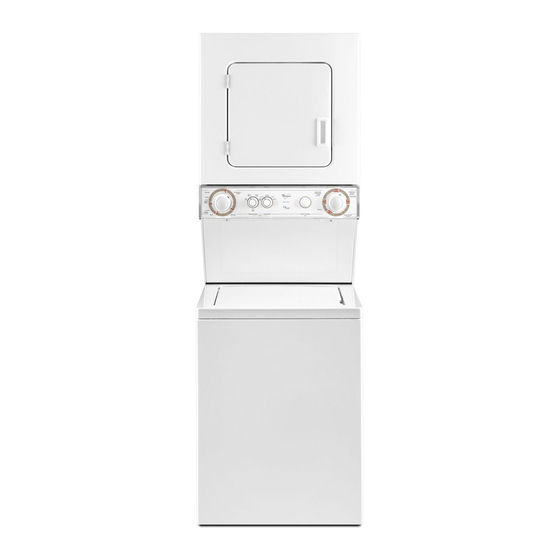Whirlpool WGT3300SQ - Gas Laundry Center Instrukcja instalacji - Strona 11
Przeglądaj online lub pobierz pdf Instrukcja instalacji dla Suszarka Whirlpool WGT3300SQ - Gas Laundry Center. Whirlpool WGT3300SQ - Gas Laundry Center 28 stron. Combination washer/electric dryer
Również dla Whirlpool WGT3300SQ - Gas Laundry Center: Specyfikacje (8 strony), Instrukcje użytkownika (28 strony)

Determine vent length and elbows needed for best drying
performance
Use the Vent system chart below to determine type of vent
material and hood combinations acceptable to use.
NOTE: Do not use vent runs longer than those specified in the
Vent system chart. Exhaust systems longer than those
specified will:
Shorten the life of the dryer.
Reduce performance, resulting in longer drying times and
increased energy usage.
The Vent system chart provides venting requirements that will help
to achieve the best drying performance.
Vent system chart
NOTE: Side exhaust installations add a 90º turn inside the dryer.
To determine maximum exhaust length, add one 90º turn to the
chart.
Number of
Type of Vent
90º turns
or elbows
0
Rigid metal
1
Rigid metal
2
Rigid metal
Install Vent System
1. Install exhaust hood. Use caulking compound to seal exterior
wall opening around exhaust hood.
2. Connect vent to exhaust hood. Vent must fit inside exhaust
hood. Secure vent to exhaust hood with 4" (102 mm) clamp.
3. Run vent to dryer location. Use the straightest path possible.
See "Determine vent path" in "Plan Vent System." Avoid 90º
turns. Use clamps to seal all joints. Do not use duct tape,
screws, or other fastening devices that extend into the interior
of the vent to secure the vent, because they can catch lint.
Level Washer/Dryer
Properly leveling your washer/dryer avoids excessive noise and
vibration.
1. Check the levelness of the washer/dryer by placing a level
on the top edge of the washer, first side to side, then front
to back.
Box or
Angled
Louvered
hoods
hoods
37 ft (11.3 m)
35 ft (10.7 m)
32 ft (9.7 m)
27 ft (8.2 m)
24 ft (7.3 m)
19 ft (5.8 m)
2. If the washer/dryer is not level, prop up the front with the
wood block and adjust the feet up or down as necessary.
Remove wood block.
3. Tilt the washer/dryer forward until the rear of the washer/dryer
is at least 4" (102 mm) off the floor. You may hear the self-
adjusting rear feet click into place. Lower the washer/dryer to
the floor. Check the levelness of the washer/dryer with a level
as shown above.
If washer/dryer will not level, recheck rear leveling legs for free
movement as described in the "Install Leveling Legs" section.
Repeat until the washer/dryer is level.
NOTE: It may be necessary to level the washer/dryer again
after it is moved into its final location.
4. After the washer/dryer is in its final location and is level, use an
adjustable or open-end wrench to turn the nuts on the front
feet tightly against the washer cabinet.
If the nuts are not tight against the washer cabinet, the
washer/dryer may vibrate.
Make Gas Connection
1. Remove the red cap from the flexible gas connector.
2. Remove the ½" NPT adapter from the flexible gas connector
(it will be necessary to use two adjustable wrenches).
3. Install the adapter on the ½" rigid gas supply pipe using pipe-
joint compound.
A. ½" rigid gas supply pipe
B. Use pipe-joint compound.
C. ½" NPT adapter
D. Do not use pipe-joint compound.
E. Flexible gas connector
NOTE: For LP gas connections, you must use pipe-joint
compound resistant to the action of LP gas. Do not use
TEFLON
tape.
®†
†®TEFLON is a registered trademark of E.I. Du Pont De Nemours and Company.
A
B
C
D
E
11
